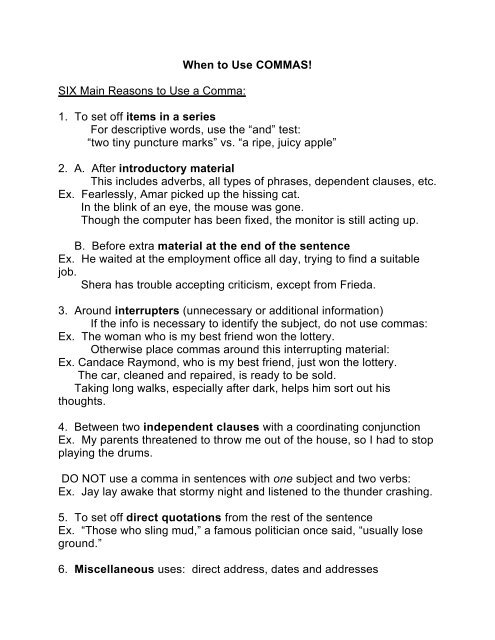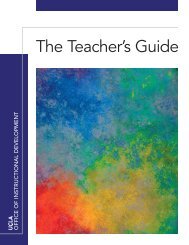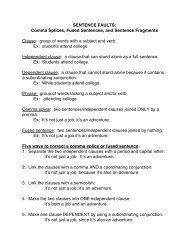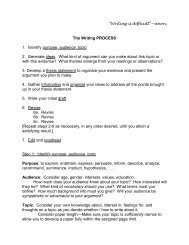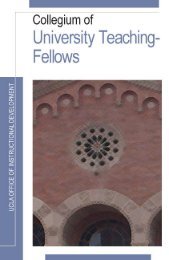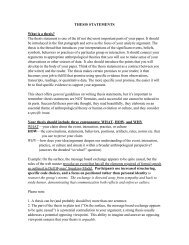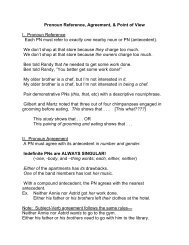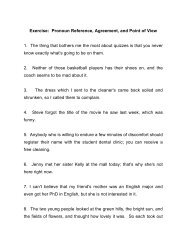Commas and Semicolons
Commas and Semicolons
Commas and Semicolons
- No tags were found...
Create successful ePaper yourself
Turn your PDF publications into a flip-book with our unique Google optimized e-Paper software.
SIX Main Reasons to Use a Comma:When to Use COMMAS!1. To set off items in a seriesFor descriptive words, use the “<strong>and</strong>” test:“two tiny puncture marks” vs. “a ripe, juicy apple”2. A. After introductory materialThis includes adverbs, all types of phrases, dependent clauses, etc.Ex. Fearlessly, Amar picked up the hissing cat.In the blink of an eye, the mouse was gone.Though the computer has been fixed, the monitor is still acting up.B. Before extra material at the end of the sentenceEx. He waited at the employment office all day, trying to find a suitablejob.Shera has trouble accepting criticism, except from Frieda.3. Around interrupters (unnecessary or additional information)If the info is necessary to identify the subject, do not use commas:Ex. The woman who is my best friend won the lottery.Otherwise place commas around this interrupting material:Ex. C<strong>and</strong>ace Raymond, who is my best friend, just won the lottery.The car, cleaned <strong>and</strong> repaired, is ready to be sold.Taking long walks, especially after dark, helps him sort out histhoughts.4. Between two independent clauses with a coordinating conjunctionEx. My parents threatened to throw me out of the house, so I had to stopplaying the drums.DO NOT use a comma in sentences with one subject <strong>and</strong> two verbs:Ex. Jay lay awake that stormy night <strong>and</strong> listened to the thunder crashing.5. To set off direct quotations from the rest of the sentenceEx. “Those who sling mud,” a famous politician once said, “usually loseground.”6. Miscellaneous uses: direct address, dates <strong>and</strong> addresses
Ex. of direct address: Please, Janie, will you stop chewing on my book?(a few examples of ) When NOT to Use <strong>Commas</strong>1. Between subject <strong>and</strong> verbThe gorilla sitting in the corner of the cage thumped his chest.2. Before part of a compound structure that is not an independent clauseMark Twain trained as a printer <strong>and</strong> worked as a steamboat pilot.3. Between a verb <strong>and</strong> its complement or objectThe best gifts are food <strong>and</strong> clothes.4. After “such as”Popular fast-food items, such as hamburgers <strong>and</strong> hot dogs, tend tobe high in cholesterol.5. Before a clause beginning with “that”They warned us that the meeting would be difficult.TWO (<strong>and</strong> ONLY two!) reasons:When to Use a SEMICOLON (;)1. to link closely related independent clausesBiography tells us about the subject; biographers also tell us aboutthemselves.The results of the study support the hypothesis; however, furtherresearch with a variety of tasks is necessary.Remember that however <strong>and</strong> other transitional words are NOTcoordinating conjunctions <strong>and</strong> need a semicolon to properly join clauses.Other such words/phrases: therefore, similarly, in fact, certainly, next, etc.2. to separate items in a series containing other punctuationWhen I cleaned out the refrigerator, I found a chocolate cake, halfeaten;a can of tomato paste, which had a blue fungus growing onthe top; <strong>and</strong> some possibly edible meat loaf.


